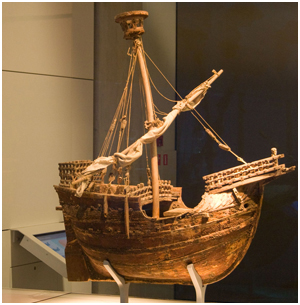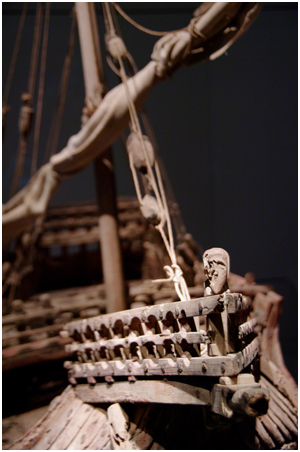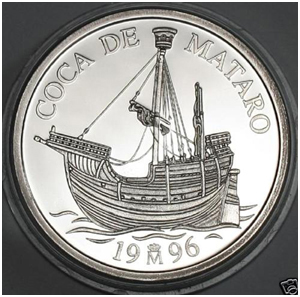|
One of the oldest and most famous medieval ship models
in Western culture is the Mataró. Presently housed in
the Maritime Museum Rotterdam based in the Netherlands,
this Mediterranean trading ship was built in the 15th
century according to recent carbon date testing. What
makes the Mataró so remarkable is it is believed to have
been presented to the Chapel of San Simón in the Spanish
town of Mataró as a dedicated gift to the Virgin Mary.
In fact, most chapels during this time were often
decorated with gifts of model ships. These gifts are
more commonly known as
ex votos,
or votive offerings to a saint or divinity. Ex votos are
given in fulfillment of a vow or devotion and are placed
in churches where worshippers seek grace or wish to show
gratitude. Sailors or other people who traveled by sea
would place ex votos in the form of paintings, as well
as ship models, in designated shrine areas and ask for
blessings on their oceanic voyages.
More than 48 inches long and 22 inches wide, the Mataró
model has been used as a basis for naval architecture
research. Additionally, it has been used as a guide to
determine cargo capacity, functional structures and
engineering elements of ships that may have existed in
the 1400s. A great deal of attention has been put into
the Mataró’s details and the model itself was more than
likely built by an actual shipbuilder. All historical
evidence indicates that the Mataró is a scale model of
an actual ship.
Unfortunately, church records of the Mataró were lost
during the Spanish Civil War and no sources have been
located that can provide indelible proof that it was
truly presented as an ex voto. For instance, models of
other ships, paintings and relics have been placed in
churches for decoration or for commemoration and not
necessarily just for the purposes of an ex voto
blessing.
Truth be known, votive ship models are well documented
through out history. To date, more than 165 votives have
been discovered during archaeological excavations dating
from 800 CE to the 1800s. Keep in mind that prior to
understanding the Gulf Stream and barometric pressure,
it was believed that God made storms at sea. Because
sailors spent the majority of their time at sea, most
felt that it was imperative to recognize a devotion to
the god of the sea through the presentation of ex voto
ship models.
A
visit to Notre Dame de Grâce chapel situated in Honfleur
on the Normandy coast reveals a mariner’s sanctuary that
is filled with ship models. Dating back to 1600,
seafarers made pilgrimages to this chapel and offered ex
voto ship models for safe returns from their perilous
journeys. Examples of the miniature vessels hang from
the churches beams to this very day. Travel to other
European coastal town churches unveil a multitude of ex
voto ship models. Furthermore, King Edward III is known
to have left a ship model at his father’s gravesite when
he was spared from a shipwreck.
Not all ship models were elaborately constructed. Many
were quite sparse and crude in design. Depending upon
artistic ability, education level and other cultural
variants, ship models could be as simple as a hollowed
out oblong-shaped bowl. Although some model shapes do
have full-sized counterparts, there is still a large
amount of information needed to interpret and record
ship model data correctly.
Based on
historical findings, archaeological evidence and
religious trends, it can be assumed that ex voto
ship models were meant as signs of appeasement and
protection. They should not be confused with
talismans, which are associated with superstitious
offerings. Ex votos are actions or material things
that are literally vowed to God in return for a
hoped-miracle or the answer of a prayer. In Latin,
ex voto translates into ‘in fulfillment of a vow’
and it is quite evident that that is precisely what
these ship models were intended to be.
|
|

Mataró Model in Maritime Museum Rotterdam.
Courtesy of
jpa2003/Joop anker

Mataró Model in Maritime Museum Rotterdam
- fragment. Courtesy of
Cybergabi

Spain
Silver 5 ECU 1996 coin featuring the
Mataró Ship Model.
From Coin catalogue. |